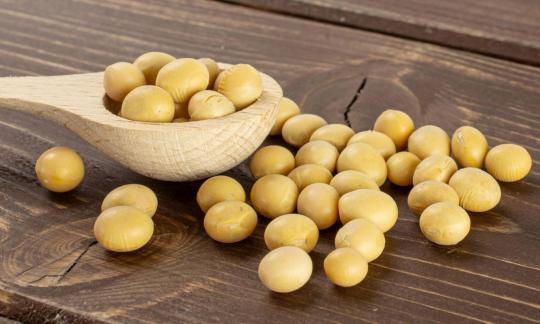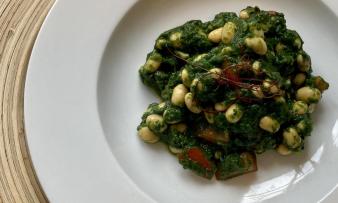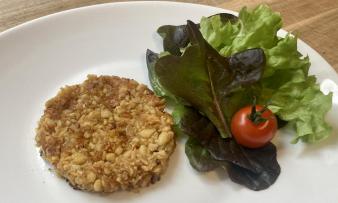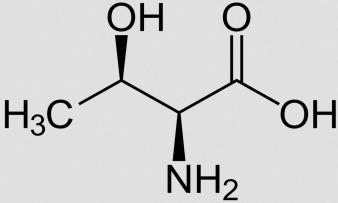Table of contents
The soybean ( Glycine max (L.) Merr.) is a legume that is very rich in protein. The ripe seeds are not edible raw.
Use in the kitchen
Raw soybeans can be brown, green, red or cream-colored depending on the variety and their shape varies from small and round to curved and oblong. They have a slightly nutty flavor. Soybeans harvested slightly unripe are called edamame. These are crunchier and sweeter in taste than the ripe seeds.
How can you process soybeans? Soybeans are processed in a similar way to chickpeas, lentils or borlotti beans. Dried beans are soaked in water overnight or for a few hours. The soaking water should be thrown away and the soybeans should be rinsed briefly with water again. Then put them in a pot and fill it with water so that the beans are completely covered. You can then cook the soybeans until they are soft.
Soybeans go well in a variety of curries, for example with potatoes, carrots and garam masala. As a vegan protein source, they can also be added to stews or soups of all kinds. Cooked soybeans can be further processed into patties or simply mixed into cooked vegetables. Raw soybeans can be used to grow sprouts and germs, which can be used as a topping on salads or Asian dishes. Soybean sprouts sold in stores are often mistakenly called mung bean sprouts. Real soybean sprouts must be heated before consumption in order to destroy the lectin phasin (see the Dangers chapter).
Soy oil is obtained by pressing the beans. A waste product from oil extraction is lecithin (soy lecithin), which can be used as an emulsifier in the kitchen. There is also vegetable fat made from soy and cotton seeds. Soy sauce (tamari), tofu, miso (soybean paste) and tempeh are also made from soy. Other soy products are: soy granules (soy shreds), soy milk, soy whipped cream, soy yoghurt, soy flour and soy pasta. Less well known is okara (soy pulp), which is produced during the production of soy milk and is used as an egg substitute in the kitchen.
Vegan Soybean Masala Recipe
Ingredients (for 2 people): 150 g raw soybeans (soaked in water for 8 hours), 1 tsp rapeseed oil, 1 onion, 2 tsp ginger, 2 garlic cloves, 1 tomato, 2 tsp garam masala (or an alternative curry spice mix), 1 pinch of salt, 400 ml drinking water.
Preparation: Wash the soybeans and soak them in water for a few hours. Cook the soybeans in fresh water until they are slightly soft. Discard the cooking water. Peel the onion and garlic cloves and chop finely. Peel a piece of ginger and grate finely. Wash the tomato and cut into pieces. Heat the rapeseed oil slightly in a frying pan and sauté the onions, garlic cloves, ginger and tomatoes until the tomatoes are soft. Add the garam masala and cooked soybeans and fry for 2 minutes. Add 500 ml of drinking water and simmer gently for 10 minutes until the water is almost completely absorbed.
| Not only vegans or vegetarians should read this: Vegans often eat unhealthily. Avoidable nutritional mistakes. |
Purchasing - Storage
Fresh soybeans can be bought in Europe in farm shops or Asian stores (more on this under Edamame). In Central Europe, the harvest usually takes place between mid-September and early October ( local season in Bavaria according to the Bavarian State Office for Agriculture ( LfL)). 23
Dried or frozen soybeans are available all year round. You can usually buy them in large supermarket chains such as Coop, Migros, Spar, Rewe, Edeka or Hofer. Other supermarkets such as Aldi, Denner, Volg, Lidl and Billa rarely stock soybeans. You can also find cooked soybeans in jars or cans, sometimes even in organic quality. Soybeans are also available in organic supermarkets such as Denn's Biomarkt or Alnatura or in health food stores, as well as in Asian shops and online shops.
The availability of soybeans varies depending on the size of the store, catchment area, etc. If you are interested, click on our recorded food prices for the DA-CH countries (above under the ingredient image). There you will find current prices from various supermarkets and their price development.
Storage tips
Dried soybeans can be kept for several years if stored properly. Fresh beans can be kept in the refrigerator for a few days and frozen soybeans can be kept in the freezer for several months.
Ingredients - Nutritional values - Calories
Raw soybeans (organic) contain 446 kcal per 100 g. Soy is an excellent source of protein and provides us with the essential amino acids. The protein content is high at 36 g/100g. It is even higher than the proportion of carbohydrates (30 g/100g). The fat content is also quite high at 20 g/100g. 1
Soybeans contain all eight essential amino acids. 100 g of soybeans cover the daily requirement of seven of them, sometimes even twice. The exception is methionine, which is present at 0.55 g/100g, which corresponds to 59% of the daily requirement. Of the amino acids, tryptophan is the most present at 0.59 g/100g (238% of the daily requirement). Hemp seeds (0.61 g) and goa beans (0.76 g) have comparable values. Dried porcini mushrooms have an even higher content at 1.5 g/100g, which corresponds to 589% of the daily requirement. The amino acid threonine is also present in abundance. 100 g contain 1.8 g, which corresponds to around 190% of the daily requirement. Brewer's yeast (2.7 g) and spirulina (3.0 g) have higher values. 1
Folate (folic acid) is plentiful at 375 µg/100g. This value is comparable to other beans, such as white beans (388 µg), kidney beans (394 µg), broad beans (423 µg) and chickpeas (557 µg). Mung beans (625 µg) and borlotti beans (604 µg) have even higher folate contents. 1 Since folate is one of the heat-sensitive vitamins and is lost even when heated slightly, the actual amount of folate (folic acid) is lower after preparation than when raw.
100 g of soybeans contain 2.5 mg of manganese, which covers 126% of the daily requirement. Chickpeas have a much higher content at 21 mg/100g. This corresponds to 1065% of the daily requirement. 1
Unsaturated fatty acids: The ratio between omega-6 and omega-3 fatty acids in soybeans is 5:1 (see ingredient tables and link in the box above). This corresponds to the recommendation of the Federal Office of Public Health ( FOPH) that the value should not exceed 5:1 (LA:ALA) on average. However, most people consume significantly more omega-6 than omega-3 fatty acids. Erb-Müesli, for example, can correct this. If you enter the "sort by health values" option in the ingredients list, you can select healthy ingredients or those that compensate for a deficiency. The ratio is reversed for linseed, for example; it contains less potentially inflammatory LA (omega-6) and more anti-inflammatory omega-3 in the form of ALA. You can find out more about this in the link to olive oil, where we explain this in detail.
The complete ingredients of cooked soybeans, the coverage of the daily requirement and comparison values with other ingredients can be found in our nutrient tables. In the article Nutrients explained you will get a detailed insight into the topic.
Health Effects
Soybeans and soy products made from them are a good vegan protein source because the ripe seeds contain all eight essential amino acids. Although the methionine content in raw soybeans is lower than the other seven essential amino acids (as mentioned above), this value is still comparable to animal sources; see our nutrient description on methionine.
Soybeans contain isoflavones, plant-based active ingredients that resemble the sex hormone estrogen, which is why they are classified as phytoestrogens. Their effect on the body has not yet been fully clarified. While cell and animal studies, for example, indicate negative effects, population studies show health benefits in the consumption of isoflavones. A 2022 study showed that the consumption of isoflavones in soy products even leads to a reduction in the risk of breast cancer in women before and after menopause. 21 Soy isoflavones do not act as estrogens, but rather have anti-estrogenic properties, which is why they are seen as a potential therapeutic agent against cancer. However, research is still needed. 22
According to the Federal Institute for Risk Assessment ( BfR), taking isoflavone supplements as a cancer prevention measure is not advisable, as there are too few studies on the effects and side effects of long-term use. However, there is nothing wrong with moderate consumption of foods containing isoflavones. 4
Dangers - Intolerances - Side effects
Can you eat soybeans raw? Fresh, frozen and dried soybeans should always be cooked before consumption and not eaten raw, as raw soybeans are poisonous. Like other legumes, they contain poisonous lectins that are sensitive to heat. A study shows that soybean lectins can be almost completely deactivated by covering them with water and cooking them for at least 10 minutes at 100 °C. In contrast, dry or moist heating (i.e. no water or only a little water) at 70 °C for several hours had little or no effect on their lectin content. 12 Germination reduces the lectin concentration in the soybeans. To be on the safe side, you can blanch the sprouts briefly and then throw away the cooking water. 14
Soybeans contain antitrypsin. This is a substance that inhibits the absorption of certain nutrients (especially proteins). According to a study, soybeans should be soaked in a 0.25% bicarbonate solution for eight hours and then boiled for at least 20 minutes. This destroys 80% of the antitrypsin activity of the soybeans. 13
Although soy is one of the 14 main allergens 10, soy ingredients are used in many different ways in the food industry. Soy contains proteins, eight of which have been classified as allergens. Particularly important allergens are β-conglycinin (Gly m5) and glycinin (Gly m6), which can trigger severe reactions. 10
People who are allergic to flower pollen should also be careful, as a cross-allergy with soy can occur (especially in the case of birch pollen allergy). Symptoms often occur immediately after ingesting soy products and manifest themselves in itching and swelling in the mouth and throat. Sensitive people can experience more severe allergic reactions. 11 Since some soy proteins are not heat-resistant, processed products are often more tolerable. 11
Ecological footprint - animal welfare
Between 2017 and 2019, 76% of the world's soy harvest was used as animal feed for meat and milk production. Only around 20% of the soybeans and the products made from them (cooking oil, tofu, miso, etc.) are eaten directly by humans. A small part (4%) of the soy is processed into biodiesel and lubricants. 9
Soy cultivation leads to the deforestation of large parts of the rainforest, especially in Brazil, the largest producer of soy, but also in Paraguay and Bolivia. 18 This is noticeable in the ecological footprint of soy from these countries of origin. The change in land use from rainforests to arable land, especially in the case of large-scale slash-and-burn clearing, releases the carbon stored in the trees and enters the atmosphere in the form of CO 2. 8
The direct environmental impacts in the affected regions are even more serious. The expansion of soy cultivation leads to the loss of remarkable and biologically unique habitats for plants and animals (loss of biodiversity). 19 The clearing of huge areas of forest and savannah (especially the Amazon and Cerrado regions) not only endangers local water resources, but also global water cycles. Droughts in neighboring areas are increasing and monoculture cultivation leads to soil degradation and water pollution in neighboring rivers and wetlands. 20
The massive use of pesticides is also ecologically questionable. In Brazil, genetically modified soy is the main crop grown. The modified plants are resistant to certain herbicides that are used extensively to control weeds. Even though this method is quick and easy to use, the negative effects on soil fertility and biodiversity should not be underestimated.
Economically, the export of soybeans is a significant source of income for countries such as Brazil and Argentina, but only a small part of the population benefits from it. On the contrary, growing soy on land that was previously used for subsistence can even endanger the food supply and livelihood of the local population. 8
Worldwide occurrence - cultivation
Where does soy come from? The cultivation of soybeans took place in China around 5000-6000 years ago. 15 Thanks to its wide range of processing and application options, soybeans are one of the most important crops in the world. According to the FAO, the most important growing countries in 2020 are Brazil, the United States, Argentina and the People's Republic of China. Brazil (as the largest producer) alone grew around 34.5% of the world harvest in 2020 (121,797,712 t). 5
Since 1997, a genetically modified (transgenic) soybean has been approved in certain countries to make weed control easier. 7 In 2019, 76% of the beans produced worldwide were genetically modified soy. 6 GMO-free soy is grown mainly in Europe, although Brazil and Russia also grow some non-GMO soybeans. 17
Found in the wild
The cultivated soybean ( Glycine max (L.) Merr.) is descended from the wild soybean ( Glycine soja). This is found as a weed on river banks and in wetlands throughout China. It also grows in Korea, Japan, parts of Afghanistan and Russia. 16 The wild form has smaller seeds than the cultivated form. There are also semi-wild forms that were created by crossing cultivated and wild soybeans. 15
Cultivation - Harvest
Soybeans can be grown in the garden bed or in a pot with a capacity of at least 5 l and good drainage. 2 Soybeans generally need a lot of warmth. You should therefore take the climatic conditions into account when choosing a variety. For example, in Central Europe you have to choose a variety that ripens early. 2,3 All soybean varieties are suitable for edamame (young, unripe seeds harvested with the pods) and dry beans. 2
Soy prefers a sunny location, protected from the wind, with loose, water-retaining soil. 2 Soybeans need nodule bacteria ( Bradyrhizobium japonicum) to grow, so the soil must be inoculated with them before sowing. You can usually buy the stems together with the seeds. 3 Sowing can take place as soon as the soil temperature is 10-12 °C (mainly between April and mid-May). Pre-cultivation indoors from April and planting in May is also possible. The seeding depth must be 3-4 cm, as soybeans are dark germinators. The distance between soybean plants should be 10-15 cm and the rows 30-50 cm. Germination only occurs after about 10-20 days. 2 Fertilization is not necessary if enough nodule bacteria have settled on the roots. A good water supply is important, especially during the flowering period (June to August). 2 Depending on the variety and the time of sowing, soybeans can be harvested between September and October. When the seeds are ripe, the entire soy plant dies and turns brown. Ideally, the dry pods on the plant rustle when touched, which is a sure sign that the soy harvest season has begun. Harvesting should ideally take place in the morning when the pods are still wet from the dew. This is because dry, ripe pods tend to burst when touched. The seeds can be removed by hand or threshed in a sack. 2
Further information
The soybean ( Glycine max (L.) Merr.) is a plant species from the subfamily Faboideae, which belongs to the family Leguminosae or Fabaceae.
Alternative names
Soybeans are often also called edamame. Strictly speaking, this name only refers to beans that are harvested slightly unripe. However, the name is also sometimes used for ripe soybeans. In English, they are called soybeans, soy beans or soya beans.
Other applications
Soybean oil is increasingly being used to produce biodiesel and printing inks. It is also used in numerous cosmetic and care products. 8
Bibliography - 23 Sources (Link to the evidence)
| 1. | USDA United States Department of Agriculture. |
| 2. | Plantura.garden Sojabohne: Anbau im Garten, Ernte & Verwendung. |
| 3. | Gartentipps.com Sojabohnen: Aussaat, Pflege und Ernte. |
| 4. | Bundesinstitut für Risikobewertung (BfR). Isolierte Isoflavone sind nicht ohne Risiko. Aktualisierte Stellungnahme Nr. 039/2007 des Bundesinstitutes für Risikobewertung vom 3. April 2007 (PDF). |
| 5. | FAOSTAT Food and Agriculture Organization of the United Nations. Soya Beans. 2020. |
| 6. | Transgen.de Gentechnisch veränderte Sojabohnen: Anbauflächen weltweit. 2021. |
| 7. | Transgen.de Sojabohne. 2022. |
| 8. | Bundesinformationszentrum Landwirtschaft. Soja - Nahrungsmittel für Tier und Mensch. 2022. |
| 9. | Ourworldindata.org Soy. 2021. |
| 10. | Medizinische Universität Wien. Die 14 wichtigsten Allergene. |
| 11. | Bundesinstitut für Risikobewertung (BfR). Birkenpollenallergiker können auf Sojaprodukte besonders empfindlich reagieren. 2007. |
| 12. | Pusztai A, Grant G. Assessment of lectin inactivation by heat and digestion. Methods Mol Med. 1998;9: 505-14. |
| 13. | Morales de León JC, Bourges Rodríguez H, Zardain MI. Cooking procedures for direct consumption of whole soybeans. Arch Latinoam Nutr. Juni 1985;35(2): 326–36. |
| 14. | Kompetenzzentrum für Ernährung (KErn). Bayerische Landesanstalt für Landwirtschaft (LfL). Hülsenfrüchte (PDF). 2018. |
| 15. | Wang KJ, Li XH, Liu Y. Fine-scale phylogenetic structure and major events in the history of the current wild soybean (Glycine soja) and taxonomic assignment of semi-wild type (Glycine gracilis Skvortz.) within the Chinese subgenus Soja. J Hered. 2012 Jan-Feb;103(1): 13-27. |
| 16. | Wu ZY, Raven PH, Hong DY (eds). Flora of China. Vol. 10 (Fabaceae). Science Press Beijing, and Missouri Botanical Garden Press: St. Louis; 2010: 251. |
| 17. | Transgen.de Ohne Gentechnik! Und wo kommt das Soja-Futter her? |
| 18. | Blonk Consultants. Environmental footprint of soy - Life Cycle Assessment. 2020. |
| 19. | WWF International. Der Sojaboom - Auswirkungen und Lösungswege. Report 2014. |
| 20. | WWF Deutschland. Soja: Wunderbohne mit riskanten Nebenwirkungen. 2020. |
| 21. | Boutas I, Kontogeorgi A, Dimitrakakis C, Kalantaridou SN. Soy isoflavones and breast cancer risk: a meta-analysis. In Vivo. 2022;36(2):556–62. |
| 22. | Douglas CC, Johnson SA, Arjmandi BH. Soy and its isoflavones: the truth behind the science in breast cancer. Anticancer Agents Med Chem. Oktober 2013;13(8):1178–87. |
| 23. | Lfl.bayern.de Sojabohne - Ernte. |










Comments